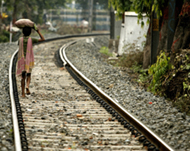China, India reducing poverty in Asia
China and India’s economic growth has reduced the number of poor Asians, but hundreds of millions in the region continue to live on less than $1 a day, the International Labour Organisation says.

Since 1990 about 250 million people have risen above that benchmark, said the report, Labour and Social Trends in Asia and the Pacific 2006: Progress toward Decent Work, released on Tuesday.
But the 600 million Asians who live below that poverty line constitute “more than two-thirds of the world’s poor”, the report said.
“If the poverty line is raised to $2 a day, Asia has about 1.9 billion poor people,” or more than three-quarters of the world total, it said.
“The two main engines behind the rise of Asia are China and India,” the report said.
“They have emerged as global economic powerhouses, shifting the growth pole from the West to the East.”
The report comes as the UN agency covering work and workplace issues prepared to open a four-day meeting on Tuesday in the South Korean port city of Busan.
The percentage of people living on $1 a day in South Asia dropped to 28.4% in 2003 from 40.9% in 1990, the report said.
In East Asia, it fell from 31.2% to 14.9%.
Discussion issues
The International Labour Organisation (ILO) meeting also plans to address an array of topics including migrant workers, labour market governance, youth and child employment and improving conditions and creating jobs.
 |
|
Child labour is one of the issues |
Lin Lean Lim, ILO deputy regional director, said “the Asian countries have done very well in terms of economic growth”.
But she added that “in terms of jobs, of new jobs for people, we haven’t done so well”.
In China, for instance, where gross domestic product grew 59% and productivity surged nearly 40% between 2000 and 2004, growth in job creation managed only about 5%, the agency’s report said.
And most Southeast Asian countries had higher joblessness in 2004 than in 1995, suggesting that the region was still suffering the effects of the 1997-98 financial crisis in the form of weak job creation, it said.
But the ILO report also cited progress in the area of child labour.
It said that the number of working children, defined as being between the ages of 5 to 14, fell to 122.3 million in 2004 from 127.3 million in 2000 in Asia, citing improved access to education.
Still, Asia has about two-thirds of the world’s children who work.
Globalisation
In the worst cases, the report said that children in the region are subjected to “slavery, trafficking into exploitative situations, debt bondage and other forms of forced labour, forced recruitment into armed conflict, prostitution, pornography and other illicit activities”.
Representatives from about 40 countries in the Asia-Pacific as well as workers’ and employers’ organisations are to attend the ILO gathering on how globalisation affects labour market and employment.
The meeting, normally held every four years, was originally scheduled for 2005 in Busan, but tension between South Korean labour organisations and the government caused organisers to postpone the meeting.